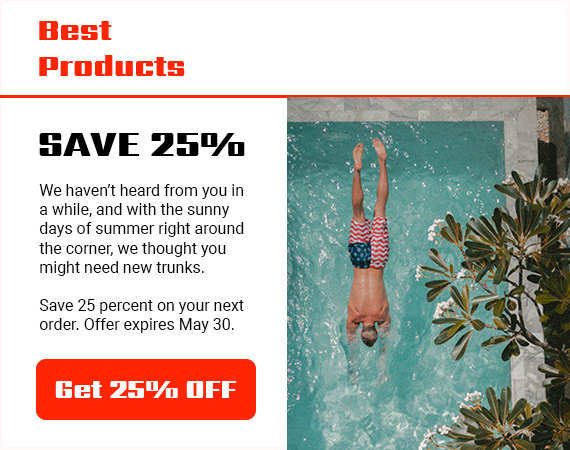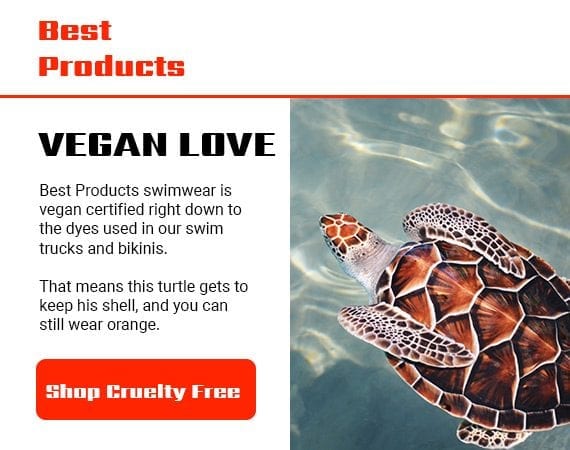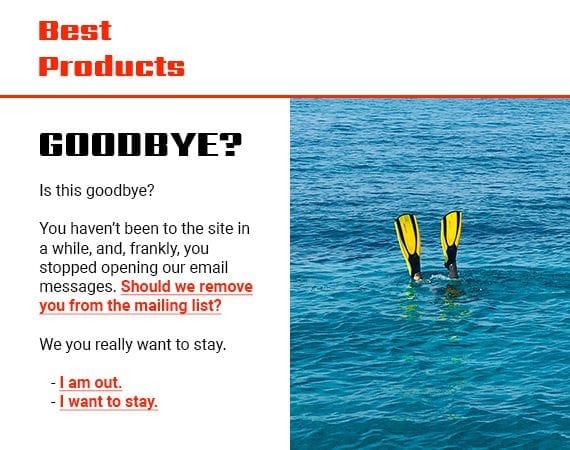A simple, three-part email automation series may help ecommerce businesses win back customers and boost profits.
For many reasons, loyal customers who return to an online store repeatedly are a key to success. These repeat shoppers cost relatively less to market to and often spend more on every order.
Sometimes, however, these customer relationships fade. A shopper may have made several purchases, but then, over time his orders become less frequent until finally, you don’t hear from him. Some first-time customers may never visit your internet store again. But your business can re-engage at least a few of them and win them back with email marketing automation.
To start, identify customers for a win-back campaign. Then initiate a short, three-part email automation series consisting of (i) an offer, (ii) values and features, and, if necessary, (iii) a goodbye. The email content — subject line, body copy, call to action — for each part will vary depending on the lapsed customer. And each part could consist of a single email message or several.
So our three-part automation might have, for example, two offer emails, three value emails, and a goodbye email for six total messages.
Offers
The first part of the win-back email automation is an offer. Your ecommerce business is reaching out to lapsed customers with a unique deal that’s better than what they would find otherwise.
This offer can take a few forms. It could be a simple discount. You might include a special free shipping offer. Perhaps the offer is a gift with purchase. Or maybe you have a special warranty you can propose.

Your win-back offer might start with a simple discount. Here the example is 25 percent off.
You don’t have to lock yourself into one particular offer. As an example, you might decide that this offer phase should consist of three messages. The first could be free, two-day shipping. The second message might include a 25-percent discount, and, the third could combine the two.
Your company should conduct A/B or multivariate tests to learn which offers or a combination of offers win back the most customers and the most profit.
In addition to the offer itself, also test the subject line, body copy, graphic elements, and even when the email messages are sent.
Features and Values
If a good deal doesn’t spur a lapsing customer, try reminding the shopper of your company’s features and values. In this phase, you are selling your company’s brand.
Focus on those things that differentiate your business from its competitors.
For example, if your products are environmentally friendly, mention this fact. If everything you sell is certified vegan and cruelty-free, tout it. If a portion of your store’s profits is donated to a charity, remind folks. Spell out your business’s value proposition in no uncertain terms.

In the value phase, you are selling your ecommerce company’s brand. Remind lapsed customers about what makes your business special.
Here again, test your emails. Which subject lines have the best open rates? Which copy produces the most clicks?
Goodbye
The final phase is goodbye. In this message, you might express regret that you have not heard from the shopper in some time and allow her to opt out of the list.

Sometimes you have to say goodbye. As a final step in the win-back campaign, put it all on the line. Give shoppers the opportunity to opt out.
This message is an emotional appeal to finally spur the customer into action. As with each phase, test to discover the best copy, subject line, and call to action.
Groups
If your ecommerce business wants to win back as many lapsed customers as possible, consider a few email automation flows. Each of these flows could focus on a different customer group.
Take the top 1 or 2 percent of your customers. These are shoppers that purchase frequently, buy high-margin items, and perhaps even refer other consumers to your business.
For a broad-line retailer with many products, these shoppers might purchase weekly. For another store, the top 1 percent might shop three or four times per year. Regardless, you should be able to identify your best customers.
The content of the offer and value phase messages should be different for customers who were once in the top 1 or 2 percent than for others.
For example, imagine a customer who made one purchase but in the past four months has not responded to an offer, not made a repeat purchase, and has not even opened an email. You would still hope to re-engage this shopper, but you might not offer the same level of discount as you would to a former top customer.
I’ve experienced this re-engagement strategy. It can be very effective. It worked for an omnichannel business with thousands of products and a direct-to-consumer manufacturer with just a few products.
For your business, identify and prioritize three or four customer groups that should receive a win-back series. Work your way through each group, testing the messages in each phase as you go. Ultimately, you’ll have a segmented, profit-boosting, automated series.